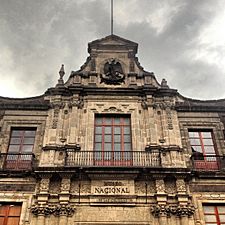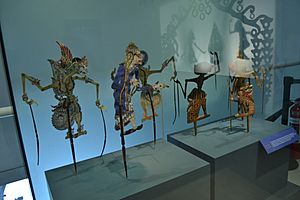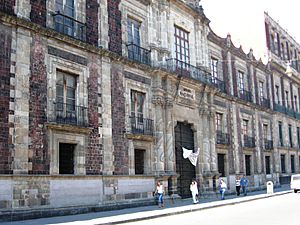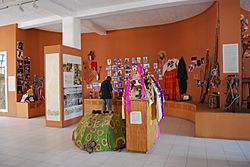Museo Nacional de las Culturas facts for kids

Above the main entrance of the museum
|
|
| Established | December 1965 |
|---|---|
| Location | Mexico City, Mexico |
| Type | Anthropology |
| Visitors | 369,865 (2017) |
| Public transit access | Metro Zócalo (Line 2) |
The Museo Nacional de las Culturas (MNC), which means National Museum of Cultures, is a special museum in Mexico City. It teaches visitors all about the different cultures of the world, both from long ago and today. The museum is inside an old building that used to be a place where coins were made. Even before that, it was the site of a famous Aztec building called the "Black House" of Moctezuma.
Contents
History of the Museum Building
The building where the museum is now has a very long and interesting history. It has been many things over hundreds of years!
The Aztec Black House
The museum stands on the very spot where an important Aztec building once stood. This building was part of Moctezuma's "New Palaces." The Spanish explorers called it the "Casa Denegrida" or "Black House." They said it was a room with no windows, painted completely black. Moctezuma would go there to think deeply and listen to advice from wise seers and shamans.
When the Spanish arrived, this Black House and Moctezuma's other palaces were almost completely destroyed. Later, Hernán Cortés was given this land by the Spanish king. He rebuilt the palace complex in a Spanish style, using many of the stones from the old Aztec buildings. His son later sold this palace back to the Spanish king, Felipe V. It then became a palace for the Spanish rulers in Mexico.
Recently, archaeologists have been digging in this area. They have found parts of a wall and a stone floor that they believe belonged to the original Black House. More digging is planned to learn even more!
The Colonial Coin Mint
At first, coins were made in the city hall. But as Mexico grew richer, more coins were needed. So, in 1731, the coin-making operations moved to this building. This new mint was very important for the economy.
Many architects worked on remodeling the building for the mint. The street where the museum is located is even named "Moneda," which means "coin," because of this building! The mint building was made even bigger between 1772 and 1779.
Becoming a Museum
In 1850, the coin mint moved to a different street. This building was then used for many different things. It was home to an engraving school, the Supreme Court, and even a government design department.
In 1865, Emperor Maximilian decided to open a public museum here. It was called the Public Museum of Natural History, Archeology, and History. It started with items given by a university and a national museum founded earlier.
A famous artist named Rufino Tamayo painted a mural called "La Revolución" (The Revolution) in the lobby. You can still see this painting today! Over time, many of the museum's collections were moved to other places. For example, the natural history items went to the Chopo Museum, and Mexican historical items went to the Castle of Chapultepec. By 1964, most of the remaining items were moved to the Museo Nacional de Antropología e Historia.
The National Cultural Museum Today


The old colonial building was declared a national monument in 1931. After the new Museum of Anthropology opened, this building was empty for a short time. Then, two people named Beatriz Barba and Julio César Olivé suggested turning it into a museum about world cultures.
After some renovations, the building opened as the Cultural Museum on December 5, 1965. This museum is special because it's the only one of its kind in Latin America that focuses on cultures from all over the world, both past and present.
The museum has sixteen rooms that show permanent exhibits and three rooms for temporary exhibits. Some rooms show very old cultures, like cave paintings and tools from early farming societies. Other rooms are about ancient civilizations like Mesopotamia, ancient Greece, and Rome.
In the "Age of Exploration" room, you can see items from when Europeans first met people in the Americas. For modern cultures, there are exhibits from every continent. You can even learn about cultures that are not well-known in Mexico, like those from Samoa or New Ireland.
Since it opened, the museum has received over 12,000 items from around the world. These include beautiful textiles, glass objects, porcelain, old photographs, weapons, kimono, masks, jewelry, and sculptures. Many of these items are original and very old. The museum still receives new donations, like a recent board with mother-of-pearl designs from Vietnam.
See also
 In Spanish: Museo Nacional de las Culturas para niños
In Spanish: Museo Nacional de las Culturas para niños



